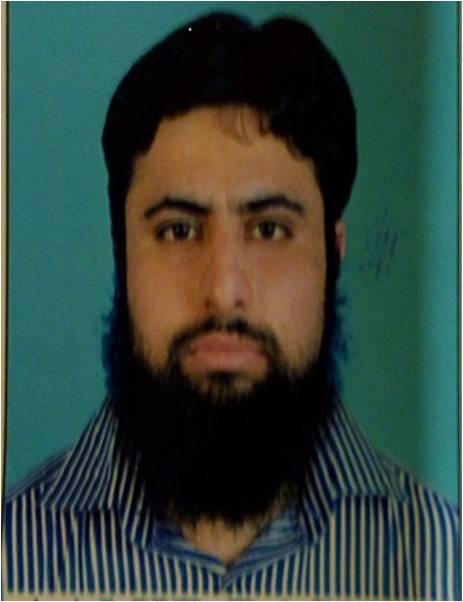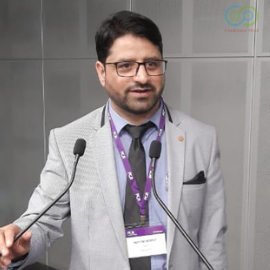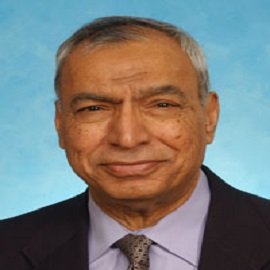Agenda
Conference Schedule
Day 1 full schedule
September 23, 2020 @ 10:30 - 19:00
Expandable polyurethane stent valve, implanted by catheter, in pediatric and adult patients: results from physical, hydrodynamic, animal and ultrastructural studies

Miguel Maluf
Full ProfessorSao Paulo Federal University, Brazil
Brasil
ABSTRACT
Background: Patients with pediatric prostheses suffer from mismatch and early calcification, which causes a high number of reoperations
Methods: Expandable Polyurethane Stent Valve – EPSV, is composed by a flexible polyurethane (PU) leaflets is grown on the top of an expandable cobalt-chrome alloy stent, including the formation of three leaflets. Physical, Hydrodynamic, Animal studies, were performed following: ISO 5840-3,2015.
Results: Physical tests. Result of study of surface scanning of pre and post crimp stent, showed no structural modification of the PU. Hydrodynamic test showed a pressure gradient oscillation between 5 to 20mm, in basal or stress condition respectively. Experimental studies. Sheep were subjected to 3D echo-Doppler study, in 6th follow-up months, which showed satisfactory hemodynamic performance, with low transvalvular gradient (M = 6.60 mm Hg).
Ultrastructural Study: Six stents were explanted after 20 days to 21 months of follow-up to Ultrastructural analysis. All of which revealed no presence of calcium growth and prostheses structure was intact.
Conclusions: Expandable Stent valve and PU no Calcification are good expectations for pediatric use.
Are Women at a much higher risk than men for experiencing drug-induced irregular beats. Understanding the Sex differences is important

Khalida Soomro
MD-FACC FAPSCMD-FACC FAPSC
Pakistan
ABSTRACT
Several drugs especially antihistamines and antibiotics have been removed from the market worldwide because they cause an abnormal heart rhythm that leads to sudden death and up to 70% of the cases occur in women. who are at a much higher risk than men for experiencing drug-induced irregular beats. The exact reason for this higher rate in women is unknown, However, a number of factors may play a role in this sex difference, a higher drug levels due to smaller body size, influence of sex hormones, differences in how drugs are broken down and transported to the heart differently or women’s hearts are inherently more susceptible to drugs that cause abnormal heart rhythms. few studies have investigated whether genetic differences between men and women have any effects on drug-induced arrhythmia (irregular rhythm). Due to the absence of appropriate tools, It is found that there are no differences in the relationship between drug concentration and EKG changes of men vs. women. However only one recent study suggests that the higher drug-induced arrhythmic risk in women compared to men is not due to larger concentration-dependent EKG effects and the EKG can be used to differentiate ion channel effects caused by drugs with different arrhythmic this concern of small body size in women for similar higher dose level than men needs further research on women’s higher drug-induced arrhythmic risk. Regarding sex hormones several studies has found that they play an important role in determining the sex differences of drug-induced irregular beats. New research has the potential to enhance drug development and safety for both women and men by improving the accuracy of the evaluation of a drug’s potential to cause heart rhythm problems, and by providing this information earlier in drug development. Also focus should be on to formulate simple and common instruments as items, questionnaires, or event diaries and can deliver information on a patient’s function, activities of daily life, symptom severity, or quality of life. These measures will provide essential information in clinical care and regulatory decisions by evaluating health status from the patient’s perspective.
Is Arni exclusive in management of chronic heart failure? 3 years experience in a Central Hospital of Indian Railway

C.K.Das
CardiologistCentral Hospital, South East Central Railway,India
India
ABSTRACT
Chronic Heart Failure (CHF) is a complex clinical syndrome, and can result from any structural or functional cardiac disorders which impair the ability of ventricles to fill with or eject blood to fulfill the demand of the organs. The incidence of CHF in India is rising due to various causes. Most important factor leading to this fatal ending disease is Coronary Heart Disease which has remarkably entered in the younger population of India. Unawareness, faulty lifestyle, poor doctor population ratio, delayed presentation of acute myocardial insult and non-availability of skilled hands in periphery have lead to the present scenario. Anti-heart failure medications, including beta-blockers, ACEIs (angiotensin-converting enzyme inhibitors), ARBs (angiotensin receptor blockers), and aldosterone antagonists, improve the chances of survival in CHF patients. However, even with optimal anti-failure medical treatment, the mortality and morbidity of patients with advanced CHF remain high. Therefore a need for an ideal therapy to address the problem has been felt. Novel therapies have emerged from an improved understanding of the pathophysiology of HF. Among them, angiotensin receptor/neprilysin inhibitors (ARNIs), described as a “game changer” by cardiologists.
It was programmed to treat the suitable patients of refractory Chronic Heart Failure with reduced Ejection Fraction (CHFrEF). To observe its safety and efficacy in long run.
PATIENTS AND METHODS
All patients admitted in medical wards and ICU with CHF with reduced EF symptomatic in form of NYHA CLASS II and above were included. Such heart failure patients who were already on (ACEI) Ramipril or Enalapril but did not show any improvement after a period of 06 months were also included in this ARNI group. Patients with persistent hypotension and known allergy to ARBs were excluded. Detail clinical examination followed by routine investigation, ECG,Chest X-ray and Echocardiography were done. Left Ventricular Internal Diameter more than 56 mm and EF 40% or low were selected for the cases. Before and after initiation of therapy evaluation protocol was followed with 6 minutes walk and Echocardiography each month. Apart from Beta blockers and Diuretics the major group after consent received ARNI 50mg twice daily to start with up titration of doses were done suitably in subsequent visits. A control group, who basically did not agree for the newer drug was given ACEI in place of ARNI.
RESULTS
Total cases studied were 211 (80female 38%).ARNI group total cases were 137 (52 female, 38%). Ischemic Dilated Cardiomyopathy were 75(55%) of which 30 post PTCA, 17 post CABG and 28 on only medical management. Non-ischemic group had 2 valvular and 60 non valvular DCM. ACEI group had 74 cases (28 females 38%). Out of 74of this group 13 PTCA, 7 CABG, 26 on medical management for Ischemic DCM. 28 were non- ischemic DCM. Ages ranged from 10 to 76 years. Study period from Dec 2016 till date. 6minutes walk and EF improvement went side by side. EF increase upto 5% after 6 months was seen in 34 cases (25%) in ARNI & 30 cases(41%) in ACEI group. EF increase by 5 to 10% seen in 79 cases(58%) in ARNI & 13 cases (18%) in ACEI group. EF increase more than 10% in 11 cases(8%) in ARNI group & none in ACEI group. No improvement in EF seen in 5 cases (8%) in ARNI group & 14 cases(41%) of ACEI group. 3 cases were discontinued from ARNI group due to persistent hypotension, 6 had adverse renal function and one case had ventricular arrhythmia.
CONCLUSIONS
Within 6 months to one year follow up ARNI shows promising results in increased performances and reduced hospitalizations in this small study. A large randomized control study is needed to understand this newer molecule in Indian set up.
Spectrum, prevalence and fetomaternal outcome of cardiac diseases in pregnancy: A single center teritiary care experience

Aamir Rashid
Assistant professorSheri Kashmir Institute of Medical Sciences ,India
India
ABSTRACT
Introduction: Cardiac disease is an important cause of maternal & fetal morbidity and mortality.
Aims & Objectives: To study the spectrum, prevalence and fetomaternal outcome of cardiac diseases in pregnancy .
Material & Methods:It was a single center observational study . All antenatal patients visting the hospital over a period of 27 months were screened for cardiac diseases by detailed clinical history , examination , Electocardiograpy and echocardiography. Type , Severity of heart disease and fetomaternal outcome were noted.
Observation & Results: A total of 9298 pregnant females were screened . 73 had cardiac disease giving a hospital based prevalence among attending patients of 7.85/1000. Out of 73 patients 22(30.13%) patients were diagnosed first time during pregnancy. The mean age of patients was 27.46±4.4 yrs. Majority were in age group 26-30 years age. 32(45%) patients were primigravida while as rest were multigravida. 58(80%) patients were in either NYHA Class I or II .Rheumatic heart disease was most common [36(46.5%)] cardiac disorder . Others included Congenital heart disease in 13(17.8%), Cardiomyopathy in 8 (10.9%), Mitral valve prolapsed in 6 (8.21%) Rhythm disorders in 4(5.4%) , Pericardial effusion in 3(4.1%) and prosthetic valve in 4 (5.4%) patients . Maternal mortality occurred in 3(4.1%) patients. Maternal morbidity in terms of those developing Congestive Cardiac failure and requiring Intensive care unit admission was in 10 (13.6%) patients .Fetal outcome included abortion in 1(1.36%) , acute fetal distress in 5(6.84%) ,Intrauterine death in 2(2.73%) , preterm delivery in 4(5.4%) patients and neonatal mortality in 1(1.36%) .MTP was done in four(5.47%) patients .Predictors of combined maternal & Fetal morbidity and mortality were advanced NYHA Class ,Prosthetic heart valves, Severe Left sided obstructive lesions & Left ventricular systolic dysfunction.(p<0.05)
Conclusion: Rheumatic heart disease was most common cardiac disorder. Thirty percent of patients were diagnosed first time during pregnancy .Advanced NYHA class, Severe LV systolic dysfunction , Severe Left heart obstructive disease and prosthetic cardiac valves were significant predictors of maternal & fetal morbidity & mortality .

Mohomed Junaideen Mohomed Nawshad
Senior RegistrarNational Hospital Kandy, Sri Lanka
Srilanka
ABSTRACT
17 year old girl presented to hospital with history of high fever and worsening of shortness of breath which she had for 3 months. On examination she had a pan systolic murmur best heard at apex, elevated JVP and a mild tender hepatomegaly was found. ECG was normal and CXR showed biatrial dilatation and pulmonary congestion. transthoracic 2D echocardium followed by TOE performed and showed EF> 50% dilated LA with large LA myxoma with a central hypoechoic area measuring 32mm x 60 mm. it is attached to IAS and highly mobile. There was grade II MR. There is significant TR with TRPG of 94mmHg with severe pulmonary hypertension. RA,RV mildly dilated and TAPSE 15. Patient underwent surgical excision of left atrial myxoma next day. on day 2 post surgery TRPG was 28mmHg.The cause of pulmonary hypertension in left atrial myxoma patients is due to mitral stenosis like pathology of the myxoma1 . Pulmonary arterial hypertension in these patients were also explained by rise in IL-6 in patient with atrial myxoma. It has shown that IL-6 is a valuable biomarker. Right sided myxomas are rare to develop pulmonary hypertension but it has been described. The cause of pulmonary hypertension in these patients are mostly due to chronic micro thromboembolic phenomenon of the tumour and associated with cytokines such as IL-6 directly entering the pulmonary circulation. Because the pulmonary hypertension in right heart myxoma caused by a chronic change in the lung vasculature, pulmonary hypertension may not resolve after resection of tumour but usually it does in left atrial myxomas2 .

Manoj Kumar
D.M NeurologyJawaharlal Nehru Medical College,India
India
ABSTRACT
Introduction: Hypothyroidism is an important endocrine disorder which results in peripheral neuropathy. Many studies reported alteration in peripheral nerve in clinical hypothyroidism but only few have evaluated the effect of subclinical hypothyroidism on peripheral nerves with conflicting results. The purpose of this study was to evaluate the effect of newly detected subclinical hypothyroidism on nerve conduction parameters.
Material and Methods:This is a case-control study conducted in 37 subjects aged between 16-45 years. Seventeen cases with subclinical hypothyroidism(defined biochemically as high serum TSH with normal level of thyroid hormones) as the study group and twenty age and sex matched subject as the control group were enrolled in the study. Patients with other possible causes of neuropathy viz. diabetes mellitus,obesity,alcoholism,liver and kidney diseases, malignancy,hereditary neuropathy or HIV infection were excluded. Patients were screened for clinical features of neuropathy. Electrodiagnostic test was performed on all 37 subjects.Motor conduction parameters viz.distal latency, CMAP amplitude and conduction velocity were estimated for median,ulnar,common peroneal and posterior tibial nerves. Sensory conduction parameters viz. SNAP amplitude and conduction velocity were estimated for median,ulnar and sural nerves. Nerve conduction parameters were recorded from right sided limbs. Data of patients were compared with those of controls by unpaired student’s t-test.
Results: Motor nerve conduction study revealed significant difference in motor conduction parameters in non-length dependent manner between two groups. Sensory nerve conduction study showed significantly reduced SNAP amplitude in sural nerve in patient with subclinical hypothyroidism as compared to controls.
Conclusion: Our study has found electrophysiological alteration revealing length dependent sensory axonal and non-length dependent demyelinating motor neuropathy in patients with subclinical hypothyroidism.

Praveen Gupta
Senior LectureGovernment Polytechnic College, Jaipur,India
India
ABSTRACT
Assessment of fetal heart rate (FHR) and fetal heart rate variability (fHRV) reveals important information about fetal well-being, specifically in high risk pregnancies. Abdominal electrocardiogram (abdECG) recording is a non-invasive method to capture fetal electrocardiograms. In this paper, we propose a methodology to extract FHR (fetal RR time series) from the abdECG recordings using the recently introduced multivariate empirical mode decomposition (MEMD) technique. MEMD breaks a signal into a finite set of intrinsic mode functions (IMFs). First, elimination of the noisier abdECG channels, based on comparison of similar indexed IMFs that were obtained through the MEMD technique, is conducted. Thereafter, denoising of the remaining abdECG channels is performed by eliminating certain similar indexed IMFs. The unwanted mother QRS complexes are removed from these noise-free abdECG channels, and the candidate fetal R-peaks are detected through a wavelet based approach. The proposed methodology is validated using an open source real-life clinical database. The proposed technique resulted in a high value (0.983) of cross correlation between the detected and true FHR signal.

Ermoshkin Vladimir Ivanovich
PhysicistRussian new University (RosNOU), Moscow
Moscow
ABSTRACT
Goal
The problem of atherosclerosis can not be solved for at least the last 100 years. On the contrary, in the 21st century, the incidence of atherosclerosis is increasing. This article describes a new hypothesis for this insidious disease. This hypothesis was first mentioned in articles [1,2].
Method
Study of numerous sources of information posted on the Internet. Discussion of proposed ideas at conferences, publication of original articles in Russian and English-language medical journals.
Results
The problem of human cardiovascular diseases is the number 1 problem for all mankind [3-5].
Coronary heart disease, angina, myocardial infarction,stroke, atherothrombosis and atherosclerosis - all these diseases of the cardiovascular system, which have already become household terms. According to who, these diseases are responsible for more than 50% of deaths in countries such as the United States, Germany and the United Kingdom. All these deaths are the result of the same process - atherosclerotic damage to the walls of blood vessels. For example, unexpected memory lapses and forgetfulness are the first symptoms and manifestations of developing atherosclerosis. Atherosclerosis over the past 30 years is getting younger right before your eyes.
Observations show that growths, plaques, fibrous tissue, and calcification of the walls are gradually formed in the arteries from the inner side. The smallest asymptomatic manifestations of atherosclerosis in the form of deposits on blood vessels can be seen already in six-year-old children. All this over time causes an increase in the stiffness of the arteries and a narrowing of their internal diameter, and, consequently, the blood supply to the heart, brain and other organs deteriorates. A person has the first signs of atherosclerosis. For some reason, very often, in parallel with atherosclerosis, a deformity of the veins develops, but of the opposite type: expansion of the internal section and their tortuosity, varicose veins, thrombosis. Why are our blood vessels "clogged"? What causes atherosclerosis and how to counteract it-these are the most serious problems facing modern medicine. In other words, the question of this article can be formed even shorter: why does narrowing of the arteries and dilation of the veins develop?
On the question of the etiology of atherosclerosis, there are quite a lot of different theories (namely, theories, not hypotheses!). We will not discuss them in detail here, but we will name the most common theories of atherosclerosis: lipid, parasitic, neuro-metabolic, emotional-stressful. Today, there are at least eight main scientific theories of atherogenesis, none of which has been strictly proved or disproved.
So, there are many theories of atherogenesis. In such cases in medical practice is a disease, do not hesitate to call polietiologichesky. This means that its occurrence depends on many different factors. On the other hand some fairer scientists say specifically: "When there are many theories, it means that there is probably no correct theory at all. And this means that the cause of atherosclerosis is still unknown."
However, since the impact of all these factors leads to the same result - atherosclerosis, we can assume that there may be some common link in their action. Without knowing its General link, it is impossible to find adequate measures to prevent an increase in arterial stiffness and narrowing of their internal diameter. The unsuccessful medical practice of studying atherosclerosis for many years confirms this. You can only influence certain factors of atherogenesis, such as cholesterol in the blood, or install stents in the artery, or use medications containing nitric oxide (NO), or apply other treatment. But there are no great successes yet.
But from the point Of view of the New theory of CVD, it turned out that there is such a common link!
A common link is arteriovenous anastomoses (AVAs) or vascular shunts. It is through the AVA [6] that arterial blood in some periods of time quickly flows into the venous channel. What are these periods? It turned out that the discovery of AVA occurs imperceptibly for the patient during physical or psychological stress, especially with prolonged inactivity, with violations of the correct lifestyle. During stress, a person's blood pressure (BP) usually rises. In order not to damage the walls of the arteries with high blood PRESSURE in the human cardiovascular system, there are AVAs: AVAs open, blood flows and there is a decrease in blood PRESSURE [6]. These are a kind of "pressure valves" in the system. After a few seconds, the AVA is closed and the blood PRESSURE can rise again. This is how arterial pressure jumps occur. The figure for the articles [7,8] shows ECG graphs with blood PRESSURE jumps, which are obtained on the "Cardiocode" device during the opening/closing of large AVAs.
Previously, a New theory of CVD [8] showed that when the Vena cava is overflowed with additional volumes of blood flowing through the AVA, a single or multiple run of the heart pulse along the vascular contour with the return of a mechanical wave to the myocardium is possible. This mechanical wave each time causes an extraordinary excitation of cardiomyocytes. Very often, this is how pathological tachycardia, some other types of arrhythmias and mechanical overload of the vascular system occur. Let me remind you that cardiomyocytes are equally well excited by both electrical and mechanical impulses.
So, the leakage of arterial blood through open shunts reduces the volume of arterial and increases the volume of venous blood. An increase in the volume of venous blood after damage or stretching of the venous valves leads primarily to edema and varicose veins of the legs, and then other organs. Gradually, so-called heart failure develops.
With a healthy heart, the right and left ventricles exit due to the Frank-Starling law maintains the corresponding blood emissions, under normal conditions, these fractions are equal.
But, with periodically opening AVA, with the help of organizational adjustments, there should be compensation for losses and the return of excess blood from the veins to the arteries by a small increase in blood flow through the small circle of blood circulation. In young people, restoring the balance of arterial and venous blood is painless, because physical activity (walking, running, swimming, gymnastics) contribute to this. In older people, problems are difficult to solve. The need to increase blood flow through the small circle of blood circulation in old age or in physical degradation of a person sometimes leads to shortness of breath, asthma and other problems, which is why breathing exercises are so useful.
A constant lack of arterial blood can lead to spasms of the arteries throughout the body. In particular, arterial blood flow may be disrupted in the hepatic or renal arteries. Because of this, there is a stagnation of blood in the liver or a small production of the daily volume of urine, or oliguria. In the latter case, diuretics can not be used, because the course of the disease due to a lack of arterial blood can only be complicated. There are numerous facts that are confirmed in medical practice.
Consider the body's adaptation to arterial blood loss. In response to regular blood leaks, the body each time begins to adapt to insufficient, i.e., to the volume of arterial blood that decreases over time and to the volume of venous blood that increases. Spasms of many arteries are forced to occur, because the volume of arterial blood and the internal volume of the entire arterial bed is always equal to each other. These volumes cannot be unequal. This is the natural state of the arterial bed.
When the volume of arterial blood is normal, all the arteries are compressed and unclenched within optimal linear limits under the influence of the blood ejection from the left ventricle.
This condition of the arteries is the least energy-consuming. This is exactly what happens in young and physically active people. But when the volume of blood drops due to leaks through the ABA, the stretching and compression of the artery walls occurs with reduced cross-sections of all the arteries.
This means that the external layers of the arteries, consisting of a sufficiently rigid " adventitia "and elastic" media " are constantly in a suboptimal state, in a state of mechanical stress, or in a state of holding the optimal diameter of the arteries from their reduction.
When the volume of blood decreases, a force directed to the axis of the arteries, i.e. inside the vessel, begins to act on all layers of the artery walls. The force is applied to the endothelium. At this time, the inner layer of the media is in a stretched, "loose" state. The elastic force of the adventitia layer is directed to the expansion of the artery, and the force of negative pressure to the axis of the vessel, i.e. in the opposite direction. Therefore, it is possible to separate the epithelium from the elastic layer of the arteries. This is what often happens in the aorta: dissection and rupture of the aorta!
Under the influence of a negative contribution to blood pressure (due to loss of arterial blood) and a decrease in the internal diameter of the arteries, the work of the smallest vessels feeding the arteries is disrupted. The smooth single-celled inner layer of the endothelium seems to be destroyed in some places due to a decrease in the total internal area of the arteries. The gaps between the endothelial cells are reduced to the limit, some cells crawl on top of each other. This creates the conditions for strengthening the internal walls of the arteries, so the development of atherosclerosis begins.
Let me remind you that in young and healthy people, arterial blood is only about 15% of the total blood volume (in the elderly, the percentage is less), the rest of the blood is in the veins, venous depots, tissues, and capillaries. This is why the cardiovascular system is so sensitive to arterial blood loss. The body's natural response is atherosclerosis.
At the beginning of the article, it was said that there are eight main theories of atherosclerosis in official medicine. In the author's opinion, each of these "theories" can only act as a factor that serves the described New theory of atherosclerosis to some extent. The reason is constant loss of arterial blood.
Lipid factor-Yes, it is involved as a factor in filling the internal volume of arteries with solid structures to reduce and strengthen this volume (cholesterol, calcium, etc. are used), as well as for the growth of plaques in places where the endothelium is damaged.
The parasitic factor is also involved, because there is necrosis and fibrosis mainly in the middle layer of the artery walls due to the deterioration of the "vessels of vessels", due to the forced reduction in the diameter of the arteries.
Neuro-metabolic and emotional stress factors are the main factors, since one-time pressure spikes or hypertension in General contributes to an increase in blood PRESSURE, stretching of the artery walls occurs. An increase in blood PRESSURE leads to the opening of AV anastomoses. All this leads to many CVD, this is described in detail in the New Theory of CVD [9-17]. Directly, AVA leads to loss of arterial blood and, as we have already found out, to atherosclerosis.
How to prevent atherosclerosis?
Apparently, it is necessary to learn how to treat hypertension using natural methods, possibly in combination with medications.
It is necessary to monitor the work of the AVA anastomoses, and it is possible to install artificial AVAs in some cases.
Apparently, it is necessary to regularly replenish the volume of arterial blood (by transfusing your own purified venous blood) and thus prevent the development of atherosclerosis.
Regular exercise, donation, vacuum cans, leeches, and Arabic hijama are useful, but with modern modifications. Breathing practices with breath delays on the exhalation are also useful for increasing CO2 in the blood and for restoring the balance of arterial and venous blood volumes.
The New Theory opens up a large space for new developments in the prevention and treatment of CVD.
Conclusions
1. The article substantiates a new mechanism of pathological arterial spasm of any caliber: it occurs as a result of arterial blood leaks through anastomoses.
2. The main medical riddle, the riddle of atherosclerosis, is Revealed. Atherosclerosis occurs due to a trivial decrease in the volume of circulating arterial blood, due to the body's attempts to keep the diameter of the artery from decreasing by increasing the hardness of the artery walls. The main cause of venous fullness and heart failure is also probably related to leaks of arterial blood into the venous pool.
3. The Author expects that the information provided in the article will cause great discussion in the medical community. The longer this hypothesis is suppressed in the medical community, the more people will lose their health.
Evaluation of tricuspid valve regurgitation and right ventricular function in pre and post permanent implantation patient by 2d and 3d echocardiography

Anup Hanchinal
MBBS MD MEDICINEJ N Medical College,India
India
ABSTRACT
Introduction: Pacemaker implantation is beneficial in patients with complete heart block and bradycardia to improve mortality and morbidity. Significant tricuspid valve regurgitation can be found after pacemaker implantation which may be due to pacing lead. Pacemaker can also improves right heart function. We have taken up this study to evaluate tricuspid valve regurgitation and RV function in pre and post PPI patients by 2D and 3D echocardiography.
Material & methods: 36 consecutive patients who were selected for chemotherapy with an age between 14 to 80 years were considered for the study. Subjects who had other associated significant Organic valvular stenotic or regurgitant Pathology were excluded from the study. Each subject had an echo assessment at pre and after the PPI implantation. And Data was analyzed.
Results: Out of 36, 14 were females and 22 were males. 11 out of 36 patients had increase in TR grading by increase in regurgitant volume and 13 out of 36 patients had improved RV function after PPI implantation. In group 1 all values was statistically non significant with p value of >0.05. in group 2 TR velocity, TR gradient RVSP, PISA radius and Regurgitant volume was statistically significant with P value of <0.05. In grouop 3 TAPSE, S’, EDV,ESV, EF and SV was statistically significant with P value of <0.05.
Conclusion: Permanent Pacemaker Implantation improves RV function but at the expense of Tricuspid Regurgition.
Epidemiology of heart failure in South India: Disease-specific prevalence, phenotypic classification, and risk factors from Manipal heart failure registry

Ajit Singh
Research associateKasturba Medical College and Hospital,India
India
ABSTRACT
Background
Heart Failure (HF) is a progressive disease and is emerging as a high epidemiological burden. However, epidemiological data is very limited from low and middle-income countries, and all projections and estimations are based on the western data.
Purpose
This study is designed to assess the HF epidemiological burden and disease-specific estimates of prevalence in the South Indian adult population for three consecutive years in various cardiac and non-cardiac conditions.
Methods and results
The Manipal Heart Failure Registry [MHFR] is a prospective registry computed the detailed epidemiology of HF at a South Indian tertiary care center for consecutive three years.
Results
Out of 167,995 screened patients 138,827 (82.6%) participants were found to be eligible for the study, and 1918 participants were diagnosed to have HF with a prevalence of 1.4% (14 per 1000). Mean age of the HF population was 64.3±12.8 years and more than half of the HF cohort was diagnosed with HFrEF (50.5%; n, 969). Males showed higher prevalence of HF than females [0.8% versus 0.6%; p<0.002]. Disease-specific HF prevalence was maximum in hypertension (5.2%) followed by anemia (4.3%). Age group (61-80 years), female gender and ischemic heart disease were the significant (P, <0.05) risk factors associated with HF.
Conclusions
The cumulative HF prevalence was estimated 1.4% in eligible population in Southern part of India. HF was more prevalent in patients with hypertension and anemia than other cardiac and non-cardiac conditions. MHFR refined the risk factors and etiologies of HF; IHD and non-ischemic cardiomyopathies were significant contributors.
Association between antioxidant status and lipid profile in patients with arterial hypertension and subclinical hypothyroidism

Anastasiia Radchenko
National Academy of Sciences of UkraineNational Academy of Sciences of Ukraine, Ukraine
Ukraine
ABSTRACT
Arterial hypertension (AH) is one of the most widespread non-communicable diseases. Subclinical hypothyroidism (SH) is known to affect lipid metabolism, that has a relevant impact on the cardiovascular risk. Oxidative stress (OS) plays an important role in the development and progression of both diseases. In our study we aimed to analyze the association between lipid profile and OS in patients with AH and SH.
Methods: Our study included 35 patients with the mean age 47,5±10,3 years (57% women, 43% men) divided into two groups: the first group (control) included patients without AH and SH (n=14), the second (comparison group) - patients with AH and SH (n=21). Measurements of serum concentrations of ferric reducing antioxidant power (FRAP), complete blood test and lipid profile were done in both the groups. Monocyte count to high density lipoprotein cholesterol ratio (MHR) as a recently emerged measure of OS also was calculated for all patients.
Results. Significant decrease in the 2nd group was found in FRAP (p=0.027). FRAP values in patients with AH and SH showed significant negative correlations with total cholesterol (TC) (r=-0,301, p=0,05), significant positive correlations with high-density lipoprotein cholesterol (r=0,344, p=0,01) and MHR (p = 0.01). Significant positive correlations were also found in the 2nd group between MHR and TC (r=-0,263, p=0,01), triglycerides (r=-0,294, p=0,01). However, in the control group MHR correlated significantly only with age (r=-0,472, p=0,05) and FRAP (r=0,496, p=0,01).
Conclusion. The obtained data indicate that antioxidant defense is impaired in patients with AH and SH, resulting in reduced levels of FRAP. This, in turn, is associated with the development of proatherogenic changes in serum. MHR can be used both as reliable indicator of antioxidant status and proatherogenic changes in patients with AH and SH.
Surgical management of embolised occlude devices and its complications-Single centre experience of ten years

Suraj Wasudeo Nagre
Associate ProfessorGrant Medical College,India
India
ABSTRACT
Introduction-In this study,we have analysed our experience in surgical management of device embolization after trans-catheter closure of atrial septal defect [ASD] and its complications.
Method-This study is a review of 25 patients out of 200 patients who underwent transcatheter closure of ASD between august 2010 to august 2020,in whom the device embolised and surgery was required for its retrieval and ASD closure.Risk factors for device embolization,its management and subsequent prognosis were discussed.
Results-Device retrieval with pericardial patch closure of ASD was done in each case.Most common site for device embolization was right atrium [12].Other site of embolization are right ventricle[ 8],left atrium[ 4] and even in pulmonary artery [1].Half patients had inadequate rims,3 patients had developed pericardial tamponade post cardiac perforation.Three patients developed femoral artery thrombosis at the catheter puncture site for which embolectomy was required.One patient developed transient ischaemic attack on postoperative day one.One patient developed left ventricular perforation and died .All other patients recovered well.
Conclusion-Closure of ostium secondum atrial septal defects by percutaneous occlude devices has significant advantages,however device embolization continues to be a major complication with chances of added morbidity of vascular complications,stroke and transient ischaemic attacks.Patient selection is of as much importance as device selection to prevent patient –device mismatch.After device embolization ,the device can be retrieved and the septal defect can still be closed surgically with good success and minimal morbidity if acted upon on an urgent basis.
Echocardiographic assessment of right ventricular functions in patients with acute myocardial infarction-A 2 year observational study from North India

Hakim Irfan Showkat
DNB CARDIOLOGYNational HeartInstitute,India
India
ABSTRACT
Objective: To study Right Ventricular functions in Acute coronary syndrome.
Method: All patients with first presentation of Acute STEMI/NSTEMI with a total of 100 patients who match our inclusion criteria were studied from June 2015 to May 2017 on Phillips Epiq 7 echocardiography Machine with follow up echocardiography at discharge.
Results- A total of 100 patients of acute myocardial infarction were studied with 73% STEMI & 27% NSTEMI & among these 68% were anterior wall MI (AWMI) & 32% inferior wal MI (IWMI). Prevalence of different risk factors observed in study population was as follows: Dyslipidaemia in 68% patients, diabetes mellitus 64%, hypertension was present in 54%, Family history of coronary artery disease (CAD) was present in 43 % of patients & Smoking was prevalent in 27 % of cases. The present study demonstrated presence of RV dysfunction assessed by echocardiography, in acute MI (STEMI/NSTEMI) irrespective of infarction location and was more commonly seen in AWMI than IWMI.
Conclusions:–The present study demonstrates presence of RV dysfunction assessed by echocardiography (RVEDD (RV end diastolic diameter), TAPSE (transannular plane systolic excursion), FAC (Fractional area change), E/E`, RV MPI (Myocardial performance index) by TDI (tissue Doppler imaging)), in acute MI (STEMI/NSTEMI) irrespective of infarction location and was more commonly seen in AWMI than IWMI. This study demonstrated presence of RV dysfunction in acute MI more so in STEMI than NSTEMI with high morbidity and mortality in patients with RV dysfunction irrespective of site of infarction.

S. Jamal Mustafa
ProfessorWest Virginia University, Morgantown, USA
USA
ABSTRACT
Adenosine acts through its receptors (A1, A2A, A2B, and A3) via G-proteins and causes an increase in coronary flow (CF) mostly through A2A. However, the role of other adenosine receptors (ARs) in the modulation of CF is not well understood. Using KOs, we investigated the role for each AR in the regulation of CF. Using the isolated heart from A3 KO mice; we reported an increase in A2A-mediated CF. Similarly, we found an increase in CF in A1 KO mice with A2A agonist (CGS-21680). Also, in A2A KO mice, response to CGS was abolished. On the other hand, A2A KO mice showed a decrease in CF to NECA (non-selective agonist). BAY60-6583 (A2B selective agonist) was without an effect on CF in A2B KO mice; however, it increased CF significantly in A2A KO. CGS also caused a significant increase in CF in A2B KO mice. Also, exogenous adenosine-induced increase in CF in WT, A2A KO, and A2B KO mice were significantly reduced with catalase. BAY-induced increase in CF in WT was significantly inhibited with glibenclamide (K+-channel blocker). Overall, our data support stimulatory roles for A2A and A2B and inhibitory roles for A1 and A3 in the regulation of CF. These observations provide new evidence for the presence of all four ARs in CF regulation. In conclusion, activation of A2A/B releases H2O2 which then activates K+-ATP channels, leading to vasodilation. These studies may lead to better understanding of the role of ARs in coronary disease and may lead to better therapeutic approaches.

Saad Alqahtani
National AmbulanceNational Ambulance UAE
UAE
ABSTRACT
Background: Out of hospital cardiac arrest (OHCA) is one of the leading causes of death worldwide. In the past, understanding the characteristics and outcomes of pediatric out of hospital cardiac arrest was a big concern in the medical field. Pediatric out of hospital cardiac arrest events are rare globally, and it was found that survival rate of out of hospital cardiac arrest was low in pediatrics as compared to adults. This condition is typically investigated and studied by ambulance services as this type of study requires prolonged time and data continuity. Initiating cardiac arrest registry in the UAE is essential to ensure collection of data from both out of hospital and in hospital cardiac arrest cases. This is also to ensure sufficiency of data validation and accurate epidemiological studies to guide proper implementation of chain of survivals.
In Middle Eastern countries, the amount of out of hospital cardiac arrest researches is low compared to other countries such as the USA or the UK. This study aims to investigate and identify the characteristics of pediatric out of hospital cardiac arrest (POHCA) in middle east. It is important to understand the characteristics of the patients to improve the implementation of chain of survival and to increase the survival rate.
This is two years prospective descriptive cohort study of pediatric out of hospital cardiac arrest group between January 2018 and December 2019. Data for this study was collected using a structured electronic questionnaire for all out of hospital cardiac arrest patients under 18 years old.
This two years study emphasized the importance of creating awareness regarding pediatric emergencies and to inculcate a sense of community engagement in public through implementing Good Samaritan Law. Development and implementation of first aid training for both parents and caregivers was suggested due to high percentage of POHCA. Data on the characteristics of POHCA was not enough and required further linkage between pre-hospital and hospitals data, as it is essential to conduct proper research and study to improve chain of survival and reduce pediatric out of hospital cardia arrest mortality rate in UAE.



